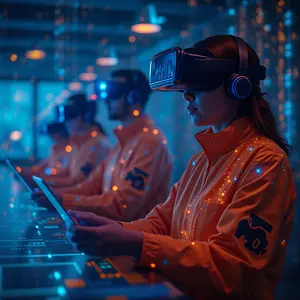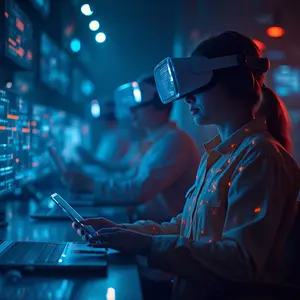Augmented & Virtual Reality
Explore the immersive potential of augmented and virtual reality for your business. Our IT services provide secure development and integration of AR/VR solutions.
What Is the Difference Between Augmented and Virtual Reality in Modern Technology?
Augmented Reality (AR) overlays digital content onto physical environments, while Virtual Reality (VR) creates immersive, simulated environments. AR leverages devices like smartphones, tablets, and optical headsets such as Microsoft HoloLens, using cameras and spatial mapping to anchor data in the real world. VR requires headsets like Oculus Rift or HTC Vive, which transport users into 360-degree digital environments with stereo audio and haptic feedback. These technologies function like different lenses—AR refines reality with data-driven context, and VR fabricates a new experiential dimension. Platforms like Unity3D and Unreal Engine facilitate cross-reality development, while SDKs such as ARKit and ARCore empower accurate motion tracking and object placement. Statista reports the AR/VR market is expected to surpass $296.9 billion by 2024, with enterprise adoption accounting for nearly 58% of that growth. Consequently, these extended realities are no longer novelties but strategic tools reshaping user experience and operational workflows.

How Are Augmented and Virtual Reality Used in Training and Education?
AR and VR revolutionize learning through immersion, simulation, and spatial interaction. VR simulates complex environments such as surgical theaters, factories, and emergency scenarios, allowing risk-free experiential training. AR enhances comprehension by projecting annotations, diagrams, and procedural guides onto physical equipment or systems. This structure mimics a live instructor guiding hand-over-hand, except with digital precision and consistency. A construction firm deployed AR-enabled helmets to assist trainees in reading blueprints on-site, reducing errors by 41% and training time by 38%.
Meanwhile, VR environments allowed machine operators to rehearse hazardous procedures in controlled simulations. All data was encrypted and synchronized to cloud repositories in compliance with ISO 27001, ensuring secure access and traceability. Accordingly, extended reality transforms passive education into active skill acquisition through dynamic spatial cognition.
What Happens When AR/VR Applications Are Deployed Without Proper Testing?
Deploying extended reality solutions without usability validation can lead to disorientation, user disengagement, and operational risk. A logistics company implemented a VR forklift simulation to replace traditional training but neglected to calibrate the headset’s field-of-view and latency thresholds. The environment felt disjointed, like navigating with blurred vision and delayed motion. Trainees reported nausea, misaligned perception, and dropped engagement. The solution required redesigning the spatial scale using Oculus developer tools and reducing frame latency below 20ms, which is critical for motion sickness prevention. In addition, ergonomics were improved with lightweight headsets and wireless controllers, while data logs were anonymized to comply with GDPR Article 5. Consequently, failure to account for user comfort and physiological feedback can negate the benefits of immersive deployment.
How Do Augmented and Virtual Reality Solutions Enhance Customer Experience?
Extended reality heightens engagement by blending physical presence with digital interactivity. AR can offer real-time product customization, spatial navigation, and contextual assistance within consumer applications. VR can simulate store environments, product demonstrations, or hospitality previews—engaging users emotionally and visually. The technology behaves like a concierge with encyclopedic precision, offering real-time guidance, previews, and personalization. A furniture retailer integrated AR to project furniture into a customer’s home using LiDAR scans and real-scale modeling. After resolving initial lighting recognition issues, conversion rates increased by 32%, and returns dropped by 17%. PCI-DSS-compliant encryption secured all transactional overlays, and session analytics were anonymized. Accordingly, immersive experience fosters emotional resonance, reduces friction, and elevates purchasing confidence.
What Role Does Hardware Play in AR and VR System Performance?
Hardware underpins the fidelity, responsiveness, and scalability of immersive solutions. Key components include spatial cameras, accelerometers, gyroscopes, processing units (GPUs), and optics calibrated for stereoscopic rendering—inadequate specifications bottleneck performance—akin to fitting a racecar engine into a bicycle frame. A corporate onboarding VR app crashed repeatedly on underpowered all-in-one headsets, failing to render high-resolution textures. Upgrades to devices with Qualcomm Snapdragon XR2 chipsets and foveated rendering reduced load times by 68% and improved session duration. Device usage was controlled through mobile device management (MDM) to enforce updates, limit unauthorized sideloading, and log session data for ISO 27017 compliance. Consequently, performance and security are interdependent variables in immersive systems architecture.

What Are the Key Development Platforms and Frameworks for AR/VR Applications?
Development ecosystems rely on engines, SDKs, and APIs tailored for real-time rendering, spatial awareness, and device integration. Unity 3D and Unreal Engine dominate the landscape for cross-platform 3D experiences. AR-specific SDKs like Apple’s ARKit and Google’s ARCore enable environmental tracking, surface detection, and object anchoring using SLAM (Simultaneous Localization and Mapping). This architecture functions like a cognitive prosthetic—observing, interpreting, and augmenting physical space. A developer deployed a museum AR tour app using Vuforia SDK, but neglected to implement cloud anchors, resulting in poor session continuity. After migration to ARKit with persistent ARWorldMaps and dynamic lighting, user retention improved by 46%. Moreover, all data interactions were encrypted using TLS 1.3, which was aligned with SOC 2 Type II requirements. Accordingly, platform selection must match both creative objectives and technical constraints.
What Compliance Considerations Must Be Addressed in AR/VR Deployments?
Compliance intersects with immersive systems via user data, biometric inputs, and environmental scans. The GDPR mandates transparency on personal data captured via headsets, cameras, and microphones. HIPAA applies when AR/VR interfaces handle protected health information like telehealth or diagnostics. A virtual wellness provider used facial recognition to personalize meditation environments, but initially failed to obtain informed consent or anonymize outputs. A regulatory review requires facial data abstraction, dynamic session IDs, and reinforcement of privacy policy. Application logs were encrypted and restricted via RBAC in line with NIST SP 800-53. Notwithstanding their novelty, AR/VR systems must adhere to the same regulatory rigor as conventional platforms.
What Benefits Do Extended Reality Systems Offer Long-Term to Business Infrastructure?
Extended reality systems offer a range of long-term benefits to business infrastructure. These include reduced training costs, accelerated knowledge transfer, enhanced visualization, and spatial analytics. AR and VR foster deeper engagement and retention, allowing complex procedures to be internalized through repetition and spatial reinforcement. A field service firm’s experience with AR-guided maintenance overlays is a testament to these benefits, as it reduced on-site support tickets by 39%. Similarly, VR-based scenario training lowered incident response time by 27% in emergency protocols. The usage metrics visualized via custom dashboards, and the audit logs maintained to support ISO 22301 business continuity requirements, underscore the long-term value of immersive systems in embedding competence, adaptability, and insight into operational DNA.
What Compliance Considerations Must Be Addressed in AR/VR Deployments?
Extended reality systems offer a range of long-term benefits to business infrastructure. These include reduced training costs, accelerated knowledge transfer, enhanced visualization, and spatial analytics. AR and VR foster deeper engagement and retention, allowing complex procedures to be internalized through repetition and spatial reinforcement. A field service firm’s experience with AR-guided maintenance overlays is a testament to these benefits, as it reduced on-site support tickets by 39%. Similarly, VR-based scenario training lowered incident response time by 27% in emergency protocols. The usage metrics visualized via custom dashboards, and the audit logs maintained to support ISO 22301 business continuity requirements, underscore the long-term value of immersive systems in embedding competence, adaptability, and insight into operational DNA.
Just Two of Our Awesome Client Reviews:
Rhonda Cerveri-Moore:
⭐️⭐️⭐️⭐️⭐️
“Reno Cyber IT Solutions helped us create a VR onboarding program that turned our training from boring to unforgettable. New hires now walk through realistic simulations before ever stepping into the workspace. The tech felt futuristic, but the local support made it practical and personal.”
Curtis Lassingame:
⭐️⭐️⭐️⭐️⭐️
“e launched an AR tool for our design team, and Reno Cyber IT Solutions guided every step. What seemed impossible at first became a seamless part of our workflow. Their team translated vision into action, and being local made them incredibly responsive.”
Transform perception into performance with Reno Cyber IT Solutions.
Our locally managed AR and VR solutions bring immersive innovation to training, operations, and customer experience.
👉 earn more about how spatial technology can elevate your organization’s engagement, efficiency, and retention.
👉 Contact us for a free consultation and immerse your business in the future—built locally, delivered brilliantly.
Augmented Reality (AR) and Virtual Reality (VR) technologies are rapidly evolving, offering compelling new ways for businesses to interact with customers, train employees, and visualize data. Expert IT services provide the crucial development and integration expertise to help organizations harness the immersive power of AR and VR. From creating interactive training simulations and enhancing product demonstrations to developing engaging marketing experiences and enabling remote collaboration, tailored AR/VR solutions can drive innovation, improve efficiency, and create unique value propositions across various industries. By strategically implementing these technologies, businesses can unlock new levels of engagement and gain a competitive edge in an increasingly digital world.
However, as with any emerging technology, security considerations are paramount in the development and deployment of AR/VR applications. The immersive nature of AR/VR often involves the collection and processing of sensitive user data, and vulnerabilities in these systems could lead to privacy breaches or even physical security risks in certain applications. IT services that prioritize cybersecurity in AR/VR development implement secure coding practices, robust authentication and authorization mechanisms, and data encryption to protect user information and ensure the integrity of the applications. By addressing security proactively, businesses can confidently leverage the transformative potential of AR and VR while safeguarding user privacy and maintaining a secure operational environment.
Ready to Secure and Support Your Business?
Your Reliable, Compliant, and Secure IT Partner:
Ready to Support and Secure Your Business Every Step of the Way.
